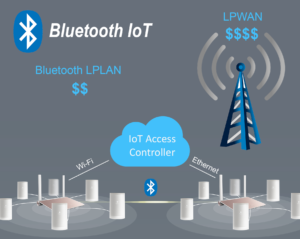#EXTENDBLE @ CassiaNetworks
In aviation circles, there is a saying, “Any idiot can fly a plane, landing is the hard part.”
Similarly, attempts to hype the advantages of Low-Power Wide-Area Network (LPWAN) Last Mile connectivity down to the sensor/device level in Industrial Internet of Things (IIoT) deployments tends to spectacularly break apart in the final 100-meters. Especially in industrial environments, where existing network infrastructure is present, LPWAN attempts to act like a LPLAN, runs into a lot of turbulence.
 Specifically, Bluetooth already has the largest worldwide installed base of sensors and communicates better in noisy IIoT environments. Therefore, re-creating a LPWAN network overlay for cellular on an existing network is extremely costly. On the contrary, an existing network can cost-effectively use standard Bluetooth resources with its low-power and low-cost sensor advantages. Also, Bluetooth open eco-system has off-the-shelf sensors, while LPWAN sensor sourcing and development costs are significantly higher.
Specifically, Bluetooth already has the largest worldwide installed base of sensors and communicates better in noisy IIoT environments. Therefore, re-creating a LPWAN network overlay for cellular on an existing network is extremely costly. On the contrary, an existing network can cost-effectively use standard Bluetooth resources with its low-power and low-cost sensor advantages. Also, Bluetooth open eco-system has off-the-shelf sensors, while LPWAN sensor sourcing and development costs are significantly higher.
#LiberateBluetooth
Notably, Cassia’s 1000-feet, extended-range Bluetooth Low Energy (BLE), and multiple connectivity capabilities pushes LPWAN even further “away” from landing many IIoT use cases. Also, a Cassia router Access Controller (AC) furthers the capacity for sensor control by creating a “star-network” of Cassia Bluetooth routers controlled by the AC. Cassia’s Bluetooth IoT system capabilities liberate Bluetooth from its short-range, single connectivity, no-control past.
LPWAN Upstream Complexity and Costs
Not only does adding a cellular overlay not make financial sense, adding LPWAN’s ongoing cellular fees and costs to an IIoT deployment are an ongoing, unnecessary burden.
Hype around a few LPWAN IIoT use cases center around narrow application, where there is no existing infrastructure to use, nor other options, often ignoring many of the most significant LPWAN challenges. Significantly, the cost of a cellular provider’s phone network band costs for licensed spectrum is in the billions. Billions.
Moreover, the cellular gateways are country and carrier specific and lack global standards. Additionally, cellular chips are vendor and carrier specific, so costs and complexity is added in any multi-nation deployment or when interacting with multiple networks. It’s a bit like changing from one type of plane to another type of plane as you cross national borders.
In cellular, the transmission costs nation-to-nation vary considerably. This basic, and inefficient model, is very unlikely to change as nation-states view licensed spectrum/band allocation as a revenue opportunity.
Bluetooth: standardized, open source, and free
By contrast, the Bluetooth network is a free (free!), open-source, worldwide standard. Also, Bluetooth is the most widely distributed and trusted sensor standard in the world. It can use existing infrastructure.
Therefore, instead of attempting to crash-land LPWAN “down” into an IIoT deployment with existing infrastructure, Bluetooth’s low cost, standardization, and ease of use factors – coupled with Cassia’s Bluetooth IoT innovations – make the case for Bluetooth IIoT taking-off from the sensor “up.”







